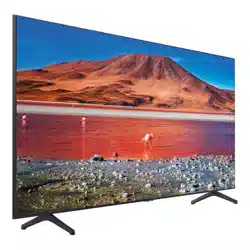Documents: Go to download!
User Manual
- User Manual - (English)
- Energy Guide - (English)

- Guide
- Troubleshooting
Table of contents
User Manual Smart TV
Guide
Connections
You can watch live broadcasts by connecting a coaxial cable to your TV and can get access to the Internet by using a LAN cable or wireless access point. Using various connectors, you can also connect external devices.
Connection Guide
You can view detailed information about external devices that can be connected to the TV.

It shows you how to connect various external devices, such as video devices, game consoles, and PCs using pictures. If you select the connection method and an external device, the connection details appear.
- Audio Device: HDMI (ARC), Optical, Bluetooth, Wi-Fi, Wi-Fi Speaker Surround Setup
- Video Device: HDMI
- Smartphone: Screen Sharing (Smart View), SmartThings, Apple AirPlay, Tap View
- PC: HDMI, Screen Sharing (Wireless), Apple AirPlay
- Input Device: Keyboard, Mouse, USB Gamepad, Bluetooth Device
- Game Console: HDMI
- External Storage: USB Flash Drive, Hard Disk Drive (HDD)

Connecting an Antenna
You can connect a coaxial cable to your TV.
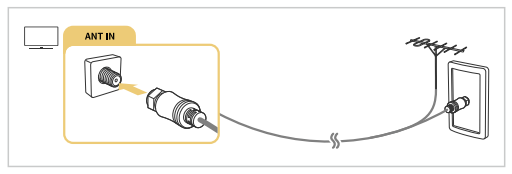
Connecting to the Internet
You can get access to the Internet through your TV.

Configure network settings to connect to an available network.
Establishing a wired Internet connection

If you connect a LAN cable, the TV automatically accesses the Internet.

Establishing a wireless Internet connection

Make sure that you have the wireless access point's SSID (name) and password settings before attempting to connect. The network name (SSID) and security key are available on the wireless access point's Configure screen. See the wireless access point's user manual for more information.
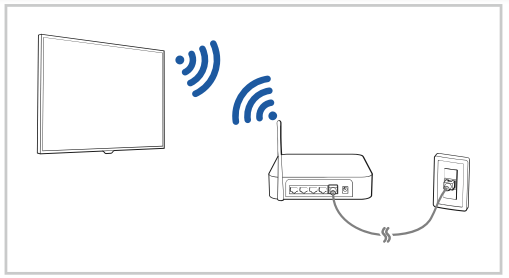
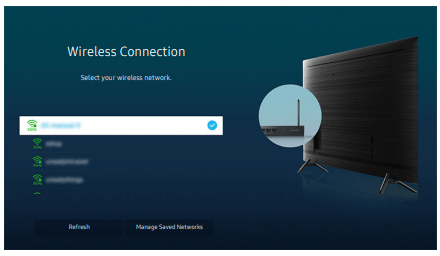
Checking the Internet connection status

Resetting Your Network

Turning on the TV with a mobile device

Connecting an IP control device to the TV

Changing the name of the TV

Screen Sharing (Smart View) with your Mobile Device
You can watch the screen of your mobile device on the TV screen through Smart View or Tap View.
For information on how to share the screen with your mobile device, refer to 

- To turn off Screen Sharing (Smart View), disconnect the mobile device or press the
 button on the remote control.
button on the remote control. - Using the Smart View menu on your mobile device, you can change the settings such as aspect ratio.
- Use AirPlay if you are an iPhone or iPad user. For more information, refer to


Using the Tap View
By tapping the mobile device on your TV, you can watch mobile device's screen through the TV screen.
1. Enable Tap View on your mobile device
2. Turn on the screen of your mobile device.
3. Tap your mobile device on the TV. The TV screen switches to mobile device's screen.
4. Watch mobile device's screen on the TV screen.
Enabling the Tap View
Enable Tap View in the SmartThings app.
1. Launch the SmartThings app on your mobile device.
2. Select Settings  in SmartThings app on your mobile device.
in SmartThings app on your mobile device.
3. Set the Tap View to on
Connection Cables for External Devices
You can view detailed information about the connection cables for external devices that can be connected to the TV
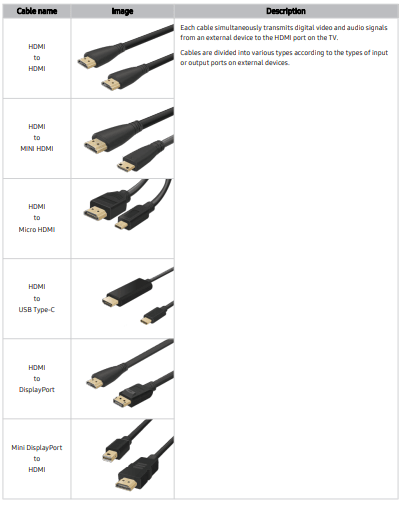
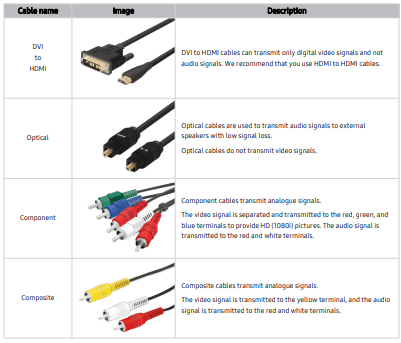
Switching between external devices connected to the TV
You can switch between TV programs and the content of external devices.

When you select a connected external device on the Source screen, the output of the selected device is displayed on the TV's screen
Editing the name and icon of an external device

You can change the port name for a connected external device or add it to the Home Screen.
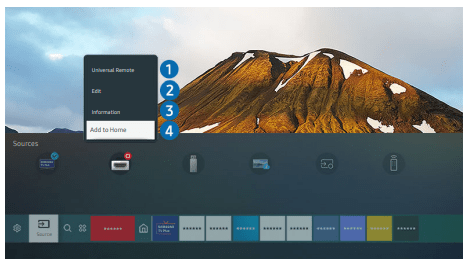
a. Move the focus to a connected external device.
b. Press the up directional button. The following functions become available:
1. Universal Remote
You can control external devices connected to the TV using a Samsung remote control. To control external devices, register them by following the instructions on the screen.
2. Edit
You can rename the input ports and change the device icons.
3. Information
You can view detailed information about an external device.
4. Add to Home
You can add the port of an external device to the Home Screen for quick switching
Using additional functions
You can use the following features on the Source screen.
- Remote Access
Use the TV to access your PC via remote PC or Screen Sharing (Wireless).
- Connection Guide
Displays device connection instructions.
- Universal Remote
Lets you register external devices to your Samsung remote control and control them using the Remote
Connection Notes
When connecting an external device, note the following:
Connection notes for HDMI
- The following types of HDMI cables are recommended:
- High Speed HDMI Cable
- High Speed HDMI Cable with Ethernet
- Premium High Speed HDMI Cable
- Premium High Speed HDMI Cable with Ethernet
- Ultra High Speed HDMI Cable
- Use an HDMI cable with a thickness of 0.66 inches (17 mm) or less.
- Using a non-certified HDMI cable may result in a blank screen or a connection error.
- Some HDMI cables and devices may not be compatible with the TV due to different HDMI specifications. This TV does not support HDMI Ethernet Channel. Ethernet is a Local Area Network (LAN) built with coaxial cables standardized by the IEEE.
- Use a cable shorter than 10 feet (3 m) to get the best UHD viewing quality.
- Many computer graphics adaptors do not have HDMI ports, but have DVI or DisplayPort ports instead. If your PC does not support HDMI video out, connect your PC with a DVI to HDMI or HDMI to DisplayPort cable.
- When the TV is connected to an external device, such as a DVD/BD player or a set-top box via HDMI, power sync mode will be automatically activated. In the power sync mode, the TV continues to detect and connect external devices via HDMI cable. This function can be deactivated by removing the HDMI cable of the connected device.
Connection notes for computers
- For the resolutions supported by the TV, refer to "Read Before Connecting a Computer (Supported Resolutions)."
- If you want to connect your PC and TV wirelessly, both of them must be connected to each other on the same network.
- When sharing content with other network-based devices, such as those in an IP (Internet Protocol) storage system, sharing may not be supported due to the network’s configuration, quality, or functionality, for example, if the network has an NAS (Network-Attached Storage) device.
Connection notes for mobile devices
- To use the Smart View function, the mobile device must support a mirroring function, such as Screen Mirroring or Smart View. To check whether your mobile device supports the mirroring function, refer to the mobile device's user manual.
- The Screen Sharing (Smart View) feature may not operate smoothly in a 2.4GHz environment. For better experience, 5.0GHz is recommended. 5GHz may be available depending on the model.
- To use Wi-Fi Direct, the mobile device must support the Wi-Fi Direct function. To check whether your mobile device supports Wi-Fi Direct function, refer to the mobile device's user manual.
- The mobile device and your Smart TV must be connected to each other on the same network.
- Use AirPlay if you are an iPhone or iPad user. For more information, refer to


- The video or audio may stop intermittently, depending on network conditions.
- When sharing content with other network-based devices, such as those in an IP (Internet Protocol) storage system, sharing may not be supported due to the network’s configuration, quality, or functionality, for example, if the network has an NAS (Network-Attached Storage) device.
Peripherals
Connect external devices such as a keyboard for ease of use.
Controlling External Devices with a Samsung Remote Control - Using the Universal Remote
Control the TV and connected external devices with a Samsung remote control.

You can control external devices connected to the TV using a Samsung remote control. To control external devices, register them by following the instructions on the screen.
Using Anynet+ (HDMI-CEC)
Control an external device connected via Anynet+ (HDMI-CEC) with the remote control.
You can use the TV's remote control to control external devices that are connected to the TV by an HDMI cable and that support Anynet+ (HDMI-CEC). Note that you can only set up and operate Anynet+ (HDMI-CEC) with the remote control.
Connecting an external device through Anynet+ and using their menus

1. Set Anynet+ (HDMI-CEC) to On.
2. Connect an HDMI-CEC-compliant device to the TV.
3. Turn on the connected external device.
The device is automatically connected to the TV. After the connection process is finished you can access the menu of the connected device using your TV remote and control the device.
Read before connecting an Anynet+ (HDMI-CEC) device
Controlling the TV with a Keyboard, Mouse, or Gamepad
Connecting a keyboard, mouse, or gamepad to make it easier to control the TV.
 You can connect a keyboard, mouse, or gamepad to make it easier to control the TV
You can connect a keyboard, mouse, or gamepad to make it easier to control the TV
Connecting a USB keyboard, mouse, or gamepad
Plug the keyboard, mouse or gamepad cable into the USB port
Connecting a Bluetooth keyboard, mouse, or gamepad

Using the keyboard and mouse
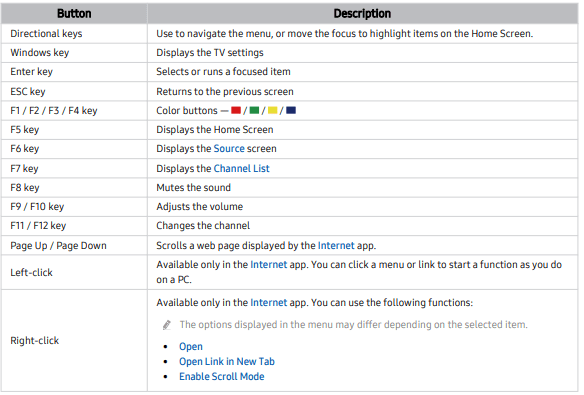
Setting up the input devices

- Keyboard Settings
You can set up the keyboard with the Keyboard Language and Keyboard Type functions.
- Mouse Settings
You can set up the mouse with the Primary Button and Pointer Speed functions.
Entering Text using the On-Screen Virtual Keyboard
Use the virtual keyboard to enter text on your TV.
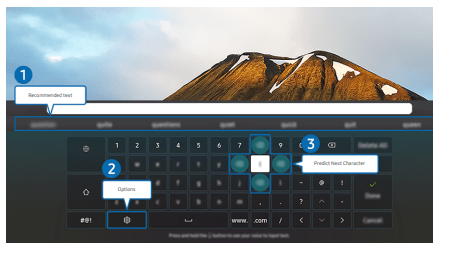
1. Recommended text
When you type a word you want to use as a search term, this function displays related suggestions from which you can choose one.
2.Options
Select  on the virtual keyboard screen. The following options are available:
on the virtual keyboard screen. The following options are available:
- Recommended text
- Reset Recommended Text Memory
- Accented Character Preview
- Predict Next Character (when using direction buttons)
- Language
3. Predict Next Character
Each time you type a character on the virtual keyboard, the next characters predicted to be typed are displayed. You can use the directional buttons on the remote control to select one.
Smart Features
You can enjoy various apps with Smart Hub.
Using Smart Hub
View descriptions of Smart Hub's basic functions.
From Smart Hub, you can use the Internet search function, install and use various apps, view photos and videos, or listen to music stored on external storage devices, and perform more functions.
Displaying the Home Screen
Press the  button
button
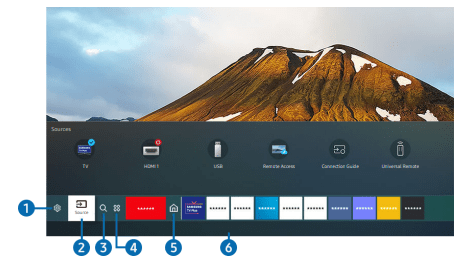
On the Home Screen, you can easily run the apps you have used previously or frequently. The apps can also be moved or deleted from the screen.
1. Settings
When the focus is moved to Settings, a list of quick settings icons appears above the top of the menu. You can quickly set frequently used functions by clicking the icons.
- e-Manual
You can open the user manual embedded in your TV.
- Picture Mode
You can select the picture mode that provides the best viewing experience. To change the picture mode, press the Select button. To makefine adjustments, press the up directional button, and then select Picture Setup.
- Sound Mode
You can select a sound mode to optimize your listening experience. To change the sound mode, press the Select button. To make fine adjustments, press the up directional button, and then select Equalizer Setup.
- Sound Output
You can select which speakers the TV uses for audio output. To change the audio output, press the Select button. To connect to a Bluetooth speaker, press the up directional button, and then select Bluetooth Speaker List.
- Game Mode
You can enable game mode to optimize the TV's settings for playing video games with a gaming console, such as a PlayStation™, Xbox™, or Nintendo Switch™. To turn Game Mode on or off, press the Select button.
- Caption
You can watch TV broadcasts with captions. To activate or deactivate the Caption function, press the Select button. To run Accessibility Shortcuts, press the up directional button, and then select Accessibility Shortcuts.
- Sleep Timer
You can have the TV automatically turn off at a specific time. To change the sleep time, press the Select button. To set the specific time at which the TV turns off automatically, press the up directional button, and then select Set Up Off Timer.
- Network
You can view the current network and Internet status. Press the up directional button, and then select Network Status or Network Settings
- Color Tone
You can select a color tone suitable for your viewing preferences. To change to a color tone that you want, press the Select button.
- Picture Clarity
You can optimize pictures that contain a lot of motions. To turn this function on or off, press the Select button. To set the detailed options, press the up directional button, and then select Picture Clarity Settings.
- Digital Output Audio Format
You can select an output format for digital audio. Note that the Dolby Digital+ option is only available via HDMI (eARC) for external devices that support the Dolby Digital+ format.
- Device Care
You can run Device Care to diagnose and optimize your TV. Device Care can also check and optimize the TV's storage. If any problem is found, the TV can call for technical support.
- All Settings
Display the Settings menu.
2. Source
You can select an external device connected to the TV.
3. Search
You can search for channels, programs, movie titles, and apps from Smart Hub.
4. Apps
You can enjoy a wide range of content, including news, sports, weather, and games by installing the corresponding apps on your TV.
5. Home
This menu appears first when you press the  button. Then you can quickly access Samsung Account, Notification or Privacy Choices.
button. Then you can quickly access Samsung Account, Notification or Privacy Choices.
- Samsung Account
Go to the Samsung Account screen to create a new account or sign out of your account.
- Notification
you can view a list of notifications for all events that occur on your TV. A notification appears on the screen when it is time to broadcast a scheduled program or when an event occurs on a registered device.
If you move the focus to notification, and then press the Select button, a notification window appears on the right and the following functions are available:
- Delete All
You can delete all your notifications.
- Settings
You can select services you want to be notified about. When you select Allow sound, notifications are displayed with a notification sound.
- Privacy Choices
You can view and set the privacy policy for Smart Hub and various other services.
6. Universal Guide
Universal Guide is an app that allows you to search for and enjoy various content, such as TV shows, dramas, and movies, in one place. Universal Guide can recommend content tailored to your preferences.
You can use this feature on your mobile device with the Samsung SmartThings app.
 Art
Art
When you are not watching TV or when the TV is turned off, you can use the Art mode function to edit image content, such as artworks, photos, or to display the content.

7. Moving an item on the Home Screen
Move the focus to the app you want to move, press and hold the Select button on the remote control, and then select Move in option menu. Move the app to the desired position by pressing the left or right directional button, and then press the Select button. The selected app is moved on the Home screen.
8. Removing an item on the Home Screen
Move the focus to the app you want to delete, press and hold the Select button on the remote control, and then select Remove in option menu. The selected app is deleted.
Launching Smart Hub automatically

When you set Autorun Smart Hub to on, the TV displays the Home Screen automatically when you turn the TV on. You can turn this function on or off. Press the Select button at the current menu.
Launching the last used app automatically

If Autorun Last App is set to on, the last used app is automatically run when you turn on the TV. You can turn this function on or off. Press the Select button at the current menu.
Testing Smart Hub connections
 Resetting Smart Hub
Resetting Smart Hub

Using a Samsung account
Create and manage your own Samsung account
 Signing in to a Samsung account
Signing in to a Samsung account
 Creating a new account
Creating a new account
 Managing your Samsung account
Managing your Samsung account

When you sign in to your Samsung account, you can use the following functions:
- Sign Out :When multiple people share the TV, you can sign out of your account to prevent others from seeing it
- Edit Profile: You can edit your account information
- Payment Info : You can view or manage your payment information.
- Back up: You can back up the TV settings to your Samsung Cloud storage. When resetting or replacing the TV, you can also restore its settings with the backed-up settings.
- Sync Internet: Once you sign in to your Samsung account and configure the Sync Internet settings, you can share the favorites and website bookmarks that you registered on other devices.
- Remove Account: You can delete an account from the TV. Although you have deleted your Samsung account from the TV, you are not unsubscribed. To unsubscribe from your Samsung Account
- Terms & Conditions, Privacy Policy: You can view the user agreement and privacy policy.
Using Remote Access
Use the TV to access your PC via Remote PC, Screen Sharing (Wireless) or Cloud Service.

You can use the TV to access your PC via Remote PC, Screen Sharing (Wireless) or Cloud Service.
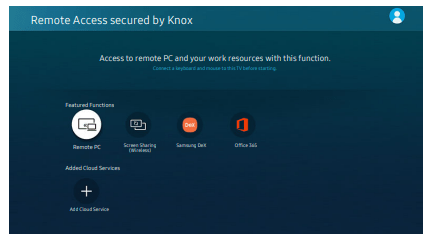
Connecting a Remote PC
Provides Remote Desktop Connection (RDP) for remotely connecting to a PC running on Windows and Virtual Network Computing (VNC) for a PC running on Mac. To remotely connect to a PC, you must enter the IP address of the remote PC or select a saved profile. Enter a correct username and password and select a correct protocol. If there is any computer that can be accessed via the same network, the found IP and protocol are displayed.
1. Configure your computer’s settings to use the Remote Access function.
- Windows OS:
1) Right-click the My Computer icon on Desktop or Windows Explorer and then click Properties.
2) Click Advanced System Settings. The System Properties window appears.
3) Click the Remote tab and then select the Allow Remote Assistance connections to this computer.
- Mac OS:
1) Select Menu System Preferences and then click Sharing.
2) Select the Screen Sharing and Remote Login check box.
3) Run the resolution changing app downloaded from App Store and then change the resolution to 1440 x 900 or lower.
2. Enter the required settings for connecting the computer remotely.
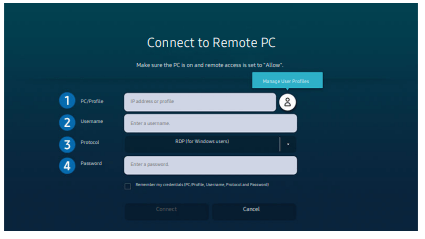
1.Enter the IP address of the PC you want to connect to.
- In case of Windows, when the computer to connect is within the same network (router/AP), run “cmd" command in Settings >Network and Internet >View Network properties or in Start >Run, and then run “ipconfig” to check the IPv4 address of the computer.
- In case of Mac, you can check the IP address in Settings >Remote Access.
- When the TV and computer are not within the same network, it is required to know the public IP and configure the router and AP. Check whether the router connected to the computer supports port forwarding. When the company provides additional security features such as firewall, seek help from a security officer.

2. Enter the Username of the computer.
How to check the Username: Control Panel User Account Control in Windows, System Preferences Users & Groups in Mac.
3. Select the Protocol for the computer’s OS. (Windows: RDP, Mac: VNC)
4. Enter the password for the login account.
For use of PIN, do not enter PIN but the specified password of the computer
Playing Multimedia Content on a Remote PC
When you move the mouse cursor to the top of the screen after accessing a remote computer, the top bar appears. When the sharing folder icon is clicked in the top bar, the folders shared on Windows or Mac OS appear. You can play back any media content in a folder.
To use this function, the folder sharing option on the computer to access must have been enabled as shown below:
- Windows OS:
1. Run Windows Explorer and then move to the folder to share.
2. Right-click the folder and then click Properties.
3. After the Properties window appears, click the Sharing tab and then click Advanced Sharing.
4. After the Advanced Sharing window appears, select the Share this folder check box.
- Mac OS:
1. Select Menu System Preferences and then click Sharing.
2. Select the File Sharing check box.
3. To add a folder to share, click the Add+ button at the bottom.
4. Select a folder and then click Add+.
Using Screen Sharing (Wireless)
Follow the instructions on the screen to adjust the PC settings and wirelessly connect the TV to the PC.
Using Samsung DeX
Samsung DeX can be connected from the TV via wireless network. When the mobile device does not appear on the screen, select Mobile Connection Guide and then follow the screen instructions
Using Office 365
You can read or create a document after accessing the office 365 website.
Adding the Cloud Service
Select the Add Cloud Service icon. Use the bookmarking function of the browser, you can add or delete the cloud service link to or from Remote Access.
Using Cloud Service
You can access the cloud service by selecting the cloud service icon added to Remote Access
The cloud service supports the following keyboard shortcuts:
- F1: Returns to Remote Access's Home screen.
- F8: Mutes the sound.
- F9/F10: Adjusts the volume.
- F11: Switches between full screen or default screen.
Using the Apps Service
Download and run various apps from Smart Hub.

You can enjoy a wide range of content, including news, sports, weather, and games by installing the corresponding apps on your TV.
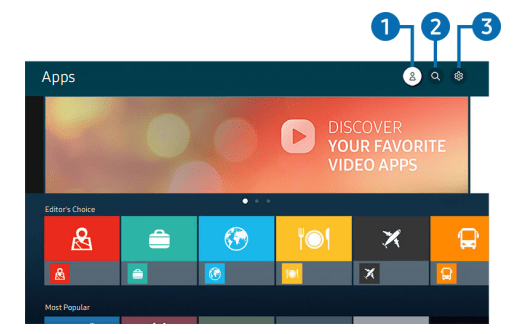
1. Samsung Account
Go to the Samsung Account screen to create a new account or sign out of your account.
2. App Search
You can search for available apps.
3. Settings
You can manage the installed apps.
Installing an app
1. Move to the app you want to install, and then press the Select button. The detailed information screen appears.
2. Select Install. When the installation is complete, the Open menu appears.
3. Select Open to run the app immediately.
Launching an app
You can run the app desired from Downloaded App. The icons below appear within the selected app's icon and indicate the following:
-
 : The app is installed on a USB device.
: The app is installed on a USB device.  : The app has a password.
: The app has a password. : The app needs to be updated.
: The app needs to be updated. : The app supports the mirroring function
: The app supports the mirroring function
Managing installed apps
Select Settings on Apps. You can manage installed apps.

1.Removing an app
1. Select an app to delete.
2. Select Delete.
The selected app is deleted.
2.Adding apps to the Home Screen
1. Select an app to add.
2. Select Add to Home.
3. After the Home Screen appears, move the selected app to the desired location.
4. Press the Select button.
The selected app is added to the Home Screen.
3.Locking and unlocking apps
1. Select an app to lock or unlock.
2. Select Lock/Unlock.
The selected app is locked or unlocked.
4.Moving apps
1. Select an app to move.
2. Select Move.
3. Move the app to the desired location.
4. Press the Select button. The selected app is moved.
5.Reinstalling an app
1. Select the app to install again.
2. Select Reinstall.
Reinstallation starts.
6.Checking the app information details
1. Select the app to check.
2. Select View Details.
The app information screen appears.
7.Automatically updating apps
To automatically update the installed apps, set Auto Update to ON.
Using the Gallery App
View photos and videos synchronized with the Samsung Cloud.

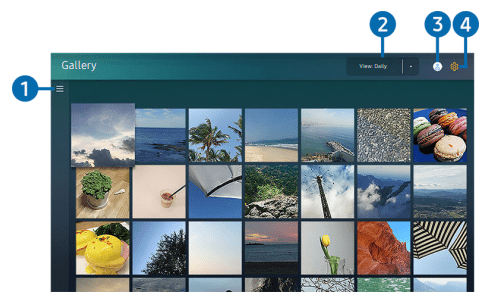 You can enjoy various content synchronized with a mobile device that supports the Samsung Cloud. The available content types are photos, videos, stories, and other content shared through your groups. If you have shared content from your groups, you can access them in noitification
You can enjoy various content synchronized with a mobile device that supports the Samsung Cloud. The available content types are photos, videos, stories, and other content shared through your groups. If you have shared content from your groups, you can access them in noitification
1.  Open category
Open category
Move to at the top left of the screen using the directional buttons on the remote control to view by category the content synchronized with the Samsung Cloud.
at the top left of the screen using the directional buttons on the remote control to view by category the content synchronized with the Samsung Cloud.
2. View: Daily / View: Monthly
Sort the content by day or month.
3. Samsung Account
Go to the Samsung Account screen to create a new account or sign out of your account.
4. Gallery Settings
Set a PIN for screen lock to restrict access to the Gallery app, or view the terms and condition.
Using the SmartThings App
Monitor and configure the smart devices you have connected to the SmartThings service.

 From your TV, you can monitor and configure smart devices you connected to the SmartThings service via the SmartThings app installed on them. You can receive noitification about the statuses of your connected devices.
From your TV, you can monitor and configure smart devices you connected to the SmartThings service via the SmartThings app installed on them. You can receive noitification about the statuses of your connected devices.
1.Location selection list
Press the Select button to identify all connected devices or the devices specific to a location
2. Samsung Account
Go to the Samsung Account screen to create a new account or sign out of your account.
3. Settings
Turn noitification on or off for the connected smart devices.
4. Scenes
Control multiple devices with one command after setting scenes via the SmartThings app on your mobile device.
5. Device list
View a list of the connected smart devices and their statuses. You can add and control new devices through the SmartThings app on your mobile device. You can check and control various devices, such as speakers, smart devices (IoT devices), andhome appliances registered on the server. Please refer to the user guide of the SmartThings app on your mobile device for more details.
Controlling your TV with the mobile SmartThings app
You can register your TV and use some features of the TV through the SmartThings app on your mobile device. Using the e-Manual Control and read the manual embedded in your TV.
Using the e-Manual
Control and read the manual embedded in your TV.
Launching the e-Manual

You can view the embedded e-Manual that contains information about your TV's key features.
Using the buttons in the e-Manual

1.  (Search)
(Search)
Select an item from the search results to load the corresponding page.
2.  (Sitemap)
(Sitemap)
It displays the lists for each item in e-Manual.
3. (Index)
(Index)
Select a keyword to navigate to the relevant page. This function may not be supported depending on the model or geographical area.
4. Moving to FAQ
You can find the troubleshooting of the selected symptom.
5. (Recently Viewed Topics)
(Recently Viewed Topics)
Select a topic from the list of recently viewed topics.

6.  (Try Now)
(Try Now)
Allows you to access the corresponding menu item and try out the feature right away.
7.  (Link)
(Link)
Access an underlined topic referred to on an e-Manual page immediately.
Picture and Sound
You can change the settings for the picture and the sound according to your preference.
Adjusting the Picture Quality
Change the Picture Mode and adjust Expert Settings.
Choosing a picture mode

You can select the Picture Mode that provides the best viewing experience.
- Dynamic : Makes the picture brighter and clearer in bright viewing environments.
- Standard : Is the default mode suitable for general viewing environments.
- Natural: Reduces eye strain for a comfortable viewing experience.
- Movie: Is suitable for watching TV or movies in a dark room.
- FILMMAKER MODE: You can watch the source content (e.g., movie) as it is. The image defined as FILMMAKER MODE automatically switches to FILMMAKER MODE while watching.
Configure advanced picture settings

Configure the screen settings to your taste by using the following functions:
- Brightness
- Contrast
- Sharpness
- Color
- Tint (G/R)
- Apply Picture Settings
- Picture Clarity Settings .
- Contrast Enhancer
- Film Mode
- Color Tone
- White Balance
- Gamma
- Shadow Detail
- RGB Only Mode
- Color Space Settings
- Reset Picture
Setting the Viewing Environment for External Devices
You can optimize the TV for viewing specific video formats.
Playing games on an optimized screen

You can enable game mode to optimize the TV's settings for playing video games with a gaming console, such as a PlayStation™, Xbox™, or Nintendo Switch™.
Adjusting the image quality of HDR game

Set the optimal resolution based on the brightness for HDR game content.
Using Cable Box IP Remote
 Set the cable box that supports IP control to be controlled with Samsung remote control.
Set the cable box that supports IP control to be controlled with Samsung remote control.
Using Input Signal Plus
 Expands the input signal range for HDMI connections
Expands the input signal range for HDMI connections
Using HDMI Black Level

Use HDMI Black Level to adjust the black level to compensate for low black levels, low contrast, or dull colors generated by external devices connected to the TV via an HDMI cable.
Changing the Picture Size and Position
Change the picture size and position for your TV.
Changing the picture size settings

- Picture Size
You can change the size of the picture displayed on the TV screen to 16:9 Standard, Custom, or 4:3.
- Fit to Screen
Fitting the picture to the screen.
- Zoom and Position
Adjusting the picture size and/or position
Configuring a Sound Mode and Expert Settings
Change the Sound Mode and adjust Expert Settings.
Choosing a sound mode

You can select the available sound mode that you prefer for a content type or your listening environment.
Configuring advanced sound settings

You can personalize the sound quality by adjusting the following settings
- Balance
- Equalizer
- HDMI-eARC Mode
- Digital Output Audio Format
- Digital Output Audio Delay
- Dolby Atmos Compatibility
- Auto Volume
- Sound Feedback
- Reset Sound
Using the Sound Support Functions
Configure the sound settings for your TV.
Selecting speakers

You can select which speakers the TV uses for audio output.
Listening to the TV through Bluetooth devices

You can connect Bluetooth audio devices to the TV. They must be paired using the TV's Bluetooth function. Refer to the user manual for your audio device such as Bluetooth speaker, sound bar, and headphones for detailed connection and usage
Listening to the TV through a Samsung audio device that supports the Wi-Fi function
For more information about how to connect and use a Samsung audio device that supports the Wi-Fi function, refer to its user manual.

If you've connected one or more Samsung wireless audio devices that support the Wi-Fi function to the TV, you can create an optimal sound set up by configuring the surround effect settings. You can select any of the surround sound configurations with or without a sound bar.
A surround sound configuration can be used if all of the following conditions are met:
- Two or more Samsung wireless speakers of the same type must be connected to the same wireless network.
- The Samsung audio devices that support the Wi-Fi function must be connected to the same wireless network as the TV.
Troubleshooting
Picture Issues
When the TV has trouble with the picture, these steps may help resolve the problem.
Testing the picture

Flickering and Dimming
If your TV is flickering or dimming sporadically, you may need to disable some of the energy efficiency features.
Disable Ambient Light Detection, Power Saving Mode, Motion Lighting, or Contrast Enhancer.

Run Picture Test. When the tested image quality is normal, check the signal of the connected device.

Component Connections and Screen Color
If the color on your TV screen is not correct or the black and white colors are off, run Picture Test.

If the test results indicate that the problem is not caused by the TV, do the following: When using the component cable, confirm that the green (Y), blue (Pb), and red (Pr) jacks are plugged into their proper connectors. For more information about how to connect an external device, run Connection Guide.

Screen Brightness
If the colors on your TV are correct but just a little too dark or bright, try adjusting the following settings first.
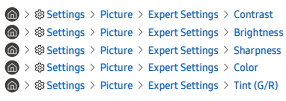
Blurring, or Juddering
If you notice blurring or juddering on the screen, use the Picture Clarity Settings function to resolve the issue.

Unwanted Powering Off
If your TV appears to turn off by itself, try disabling some of the TV's energy ʪ˙efficiency functions. See if Sleep Timer has been enabled. The Sleep Timer automatically turns the TV off after a specified period of time

If the Sleep Timer has not been enabled, see if Auto Power Off or Off Timer has been enabled and disable it.

Problems Powering On
If you are having problems powering on your TV, there are a number of things to check before calling the service department. Confirm that the TV's power cord is connected correctly at both ends and that the remote control is operating normally. Make sure that the antenna cable or cable TV cable is firmly connected. If you have a cable box or satellite box, Confirm that it is plugged in and turned on.
Unable to find a Channel
If your TV is not connected to a cable box or satellite box, run Auto Program

When using a broadcast receiver such as set-top box and IPTV, check the connection to the TV.

When the symptom persists, contact your service provider
The TV image does not look as good as it did in the store
Store displays are tuned to a digital UHD channel or HD channel. Change the output resolution of your devices, such as digital broadcast receiver, IPTV, and set-top box to UHD or HD. Be sure to use an HDMI cable to enjoy high quality videos.

To connect the TV with your PC, make sure that your PC's graphic card supports UHD resolutions. For more information about the supported UHD resolutions, refer to "Supported Resolutions for UHD Input Signals."
The picture is distorted
The compression of video content may cause picture distortions, especially in fast moving pictures from sports programs and action movies. If the signal reception is weak or poor, screen distortion may be visible but it is not a malfunction. Mobile phones used close to the TV (within 3.2 ft) may cause noise on analog and digital channels.
The color is wrong or missing
If you’re using a Component connection, make sure that the Component cables are connected to the correct jacks. Incorrect or loose connections may cause color problems or a blank screen.
The color is poor or the picture is not bright enough
Go to Picture and then adjust the Picture Mode, Brightness, Sharpness, and Color settings.

See if Power Saving Mode has been enabled

Try resetting the picture.

There is a dotted line on the edge of the screen
Change Picture Size Settings to16:9 Standard

The picture is black and white
Use a composite cable when you connect AV equipment to the TV. If you are using the composite cable, connect the video cable (Yellow) to the VIDEO (Yellow / Green) input port.
The picture won’t display in full screen
HD channels will have black bars on either side of the screen when displaying upscaled SD (4:3) content. Black bars will appear at the top and bottom of the screen when you watch movies that have aspect ratios different from your TV. Adjust the picture size options on your external device or set the TV to full screen.

The Caption function in the TV menu is deactivated
When an external device is connected with an HDMI or Component cable, the Caption function is unavailable. Adjust the caption setting on the external device.
Captions appear on the TV screen
Turn off the Caption function in Caption Settings.

The HDR of the connected external device turns off
Expand the reception range of the corresponding HDMI input signal in Input Signal Plus.

Sound and Noise Issues
When the TV has difficulties with sound, these steps may help resolve the problem
Testing the sound

How can I connect an audio device to the TV?
The connection method may differ depending on the audio device, such as HDMI (eARC), Optical, Bluetooth, and Wi-Fi.
For more information about how to connect an audio device, run Connection Guide.

There is no sound or the sound is too low at maximum volume.
Check the volume control of your TV, and then check the volume control of the external device (cable box or satellite box, DVD, Blu-ray, etc.) connected to your TV.
Check the cable connection between an external device and the TV and then try cable connection again.
The picture is good but there is no sound.
Set Sound Output to TV Speaker.

If you are using an external device, check the device’s audio output option. For example, you may need to change your cable box’s audio option to HDMI if the box connected to your TV is using an HDMI cable. To listen to computer sound, connect an external speaker to the computer’s audio output connector. If your TV has a headphone jack, make sure there is nothing plugged into it. Reboot the connected device by disconnecting and then reconnecting the device’s power cable. With a set-top box or cable box, check the cable connection and reboot the external device. When the symptom persists, contact your service provider.
No sound is heard.
Check whether Digital Output Audio Format is set to Pass-Through. If you select the Pass-Through option to use an AV receiver that does not support Dolby Digital+, no sound is output with Dolby Digital+ content. It is recommended to set Digital Output Audio Format to Auto when the connected receiver supports only the limited audio formats.

The speakers are making an odd sound.
Run Sound Test.

Make sure that the audio cable is connected to the correct audio output connector on the external device. For antenna or cable connections, check the Signal Information. A low signal level may cause sound distortions.

The sound is interrupted
The sound may frequently be interrupted when a Bluetooth speaker is used. Make sure that the Bluetooth speaker and the wireless access point are on a straight line, and the Bluetooth speaker is placed as close as possible to the TV. To minimize interruptions, we recommend a wireless access point that uses a 5 GHz frequency. When the symptom persists, it is recommended to use wired connection such as HDMI eARC and Optical.
Whenever a function is used on the TV or the channel is changed, the TV voices the activity. The TV explains in voice-over the video scenes displayed on the screen.
Turn off the Voice Guide function in Voice Guide Settings.

The TV audio is not being played through the AV receiver.
Check the A/V receiver's power supply and its settings.
- When connecting the optical cable between the TV and A/V receiver, make sure that the sound output is set Optical on your TV.
- In case of HDMI eARC connection, make sure that it is connected to the eARC dedicated HDMI port on your TV. However, the eARC can be used only when the A/V receiver supports the eARC feature.
The sound is not heard clearly.
Change to an appropriate sound mode.

The volume of the external device cannot be adjusted.
Check the cable connection between the TV and the external device. When connecting an external speaker such as home theater via HDMI, make sure it is connected to the HDMI (eARC) port on the TV. Make sure that the 

I want to turn off and on the TV and audio device at the same time.
When you connect the Samsung Soundbar to the TV via Bluetooth, the power turns off and on together. It may not be supported depending on the Samsung Soundbar model. When you connect an audio device that supports HDMI eARC to the HDMI (eARC) port on the TV, the power turns off and on together.
Channel and Broadcast Issues
When the TV has difficulties receiving broadcasts, these steps may help resolve the problem.
“Weak or No Signal” displayed in TV mode or cannot find channel.
Make sure that the external device is connected securely and turned on. Move to Sources to switch to other input sources.

When using a set-top box or cable box, check the broadcast signals or the network that is connected to the external device.
The TV is not receiving all channels.
Confirm that the coaxial cable is securely connected to the TV. Run Reset or Auto Program.

The captions are not provided on a digital channel. I want to turn off the captions.
When watching channels with the antenna cable connected, run Caption Settings.

Some channels may not have caption data. When watching a channel on an external device such as set-top box and cable box, turn on the caption function on the device. For more information, contact your service provider.
Broadcasting is deactivated.
Broadcasting is only available when Source is set to TV. Broadcasting cannot be accessed while you watch TV using a cable box or satellite box.
External Device Connectivity Issues
When the TV has difficulties connecting to external devices such as a PC, game console, or mobile device, these steps may help resolve the problem
The "Mode Not Supported" message appears.
Adjust the output resolution of the external device to a resolution supported by the TV.
The video is OK but there is no audio.
If you are using an HDMI connection, check the audio output setting on your PC. If you are using a DVI to HDMI cable, a separate audio cable is required. To listen to the computer sound, connect external speakers to the audio output connection of the computer.
I want to connect to a PC and mobile device via screen mirroring.
To wirelessly connect the TV to your PC, read the instructions at PC> Screen Sharing (Wireless) in Connection Guide, and then try to connect.

To wirelessly connect the TV to your mobile device, read the instructions at Smartphone> Screen Sharing (Smart View) in Connection Guide, and then try to connect

If the TV has difficulties connecting to your PC or mobile device due to surrounding radio interferences, change the frequency of the wireless access band, and then try to connect.
No screen appears when connecting the TV to an external device.
For more information about how to connect an external device, run Connection Guide.

Make sure that the external device is connected securely and turned on. Move to Sources to switch to other input sources.

Using HDMI Troubleshooting, you can check the connection to HDMI cable and external devices (takes approximately 2 minutes).

When using a set-top box or cable box, check the broadcast signals or the network that is connected to the external device.
The PC screen does not appear or it flickers
When the PC screen does not appear or the PC is not recognized, check the power supply of the PC and then reconnect the HDMI cable between the PC and TV. When the symptom persists, check that the PC is in Sleep mode. When the set resolution is not matched, the screen may flickers. For the PC supported resolution, see 'Read Before Connecting a Computer (Supported Resolutions).'
Network Issues
When the TV has difficulties connecting to the Internet, these steps may help resolve the problem.

Wireless network connection failed. Unable to connect to a wireless access point
Make sure that no items that can generate electromagnetic interferences are placed between the TV and the wireless/wired access point. Check if the access point is turned on. If it is on, turn it off, wait 1 or 2 minutes, and then turn it on. Enter the correct password if required. If the wireless connection fails, connect the TV to the access point via a LAN cable. If the TV can connect to the Internet normally via the wired connection, there might be a problem with the access point. In this case, try using a different access point.
Wired network connection failed.
Check if the LAN cable is plugged in on both ends. If it is plugged in, check if the access point is turned on. If it is on, turn it off, wait 1 or 2 minutes, and then turn it on.
Auto IP configuration failed. Unable to connect to the network.
Check if the LAN cable is plugged in on both ends. If it is plugged in, check if the access point is turned on. If the access point is on, turn it off, wait 1 or 2 minutes, and then turn it on. Disconnect and then reconnect the power cable of the TV, or press and hold the power button for 3 seconds.
Connected to a local network, but not to the Internet.
1. Check if the Internet LAN cable is connected to the access point's external LAN port.
2. Check the DNS setting in IP Settings.

Network setup is completed, but unable to connect to the Internet.
If the problem persists, contact your Internet service provider.
Anynet+ (HDMI-CEC) Issues
When Anynet+ (HDMI-CEC) isn't working, these steps may help resolve the problem
What is Anynet+?
You can use the TV's remote control to control external devices that support Anynet+ (HDMI-CEC) and that are connected to the TV via an HDMI cable. For example, if a connected external device supports Anynet+, you can have the connected device turn on or off when you turn the TV on or off.
Anynet+ does not work.
Confirm that the device is an Anynet+ device. The Anynet+ system supports Anynet+ devices only. Check if the power cord of the Anynet+ device is properly connected. Check the cable connections of the Anynet+ device. Go to Anynet+ (HDMI-CEC) and see if Anynet+ (HDMI-CEC) has been set to On

Anynet+ may not function when some other functions are active, including Channel Search, Smart Hub, Initial Setup, etc. If you have disconnected and then reconnected the HDMI cable, scan for devices again or turn your TV off and on.
I want to start Anynet+. I also want the connected devices to turn on when the TV is turned on.
Move the focus to the Anynet+ device at  , press the up directional button to move to Anynet+ (HDMI-CEC), and then press the Select button. Check if the Anynet+ device is properly connected to the TV, and then select Anynet+ (HDMI-CEC) menu to see if Anynet+ (HDMI-CEC) is set to On
, press the up directional button to move to Anynet+ (HDMI-CEC), and then press the Select button. Check if the Anynet+ device is properly connected to the TV, and then select Anynet+ (HDMI-CEC) menu to see if Anynet+ (HDMI-CEC) is set to On

I want to exit Anynet+. It is inconvenient to turn on other devices because the TV also turns on. It is inconvenient because the connected devices (e.g. set-top box) turn off together.
To turn off the Anynet+ function of a device connected to the TV, turn off the Anynet+ (HDMI-CEC) function of the device.

When Anynet+ (HDMI-CEC) is turned off, the sound bar connected via the HDMI (eARC) port does not turn off and on together with the TV. To prevent a specific device connected to the TV from turning off automatically, turn off the HDMI-CEC function on a specific device connected to the TV
The message "Connecting to Anynet+ device..." or "Disconnecting from Anynet+ device" appears on the screen.
You cannot use the remote control when the TV is configuring Anynet+ or switching to the TV viewing screen. Use the remote control after the TV has completed the Anynet+ configuring or has switched to the TV viewing screen.
The Anynet+ device won't play.
You cannot use the play function when Reset is in progress
The connected device is not displayed.
Check whether the device supports Anynet+. Anynet+ devices must be connected to the TV using an HDMI cable. Make sure the device is connected to your TV with an HDMI cable. Some HDMI cables may not support Anynet+. Check whether the HDMI cable is properly connected. Go to Anynet+ (HDMI-CEC) and see if Anynet+ (HDMI-CEC) has been set to On.

Scan for Anynet+ devices again. If the connection is terminated because there has been a power failure or the HDMI cable has been disconnected, please scan for the device again.
Remote Control Issues
When the remote control isn't working, these steps may help resolve the problem
The remote control does not work.
The connection between the remote control and the TV may be lost. Also, if the remote control is not working or slow, the batteries might be low or dead. If this is the case, replace the batteries. Alkaline batteries are recommended for longer battery life.
External devices cannot be operated with the TV remote control.
Check the cable connection between the TV and external devices. When the symptom persists, set it manually in 
Apps
When apps aren't working, these steps may help resolve the problem
I launched an app, but it's in a different language. How can I change the language?
Languages supported by an app may be different from the TV Language set in the menu. The ability to change the language depends on the app's provider
The app does not work properly. Its image quality is poor.
Check the network connection. When the network speed is slow, the app may not work or its image quality may be poor. The services of your application are not provided by the TV but by the application service provider. Refer to the Help section on the application service provider's website.
Media Files
When files don't play, this may help resolve the problem.
Some files are interrupted during playback.
This problem may occur with unsupported files or high-bitrate files Most files can be played back, but some files may not play smoothly.
Some files can't be played.
Some files that use an unsupported codec may not be played back. Make sure that the codec is supported by the TV. For more information, refer to "Read Before Playing Photo, Video, or Music Files."
Voice Assistant Issues
When the Voice Assistant isn't working, these steps may help resolve the problem
The voice commands do not work well
Voice commands may differ depending on the Voice Assistant. Refer to the command examples for each Voice Assistant.

With Samsung Smart Remote, the following features are available except for voice recognition. There is no response even if the voice entry button is pressed.
Try pairing the remote control with the TV.
During voice recognition, the heavy load message appears and the function does not work.
Unplug and then plug the TV power cable and then try again after 1 minute and 30 seconds. It may take a while if the voice recognition server is being inspected.
I want to see weather information of the desired area.
Say with the area name included.
Other issues
Use these procedures to resolve other issues that may occur in relation to the product
The TV is hot.
Watching TV for an extended period of time causes the panel to generate heat. The heat from the panel is dissipated through internal vents running along the top of the TV. The bottom, however, may feel hot to the touch after extended use. Children watching TV need constant adult supervision to prevent them from touching the TV. This heat, however, is not a defect and does not affect the TV's functionality.
The TV smells like plastic.
This smell is normal and will dissipate over time.
The settings are lost after 5 minutes or every time the TV is turned off.
If Usage Mode is set to Retail Mode, the TV's audio and video settings are automatically reset every 5 minutes. Change Usage Mode to Home Mode.

The TV is tilted to the side.
Remove the base stand from the TV and reassemble it.
The stand is wobbly or crooked.
Refer to the Quick Setup Guide and make sure that the stand is assembled correctly.
PIP is not available.
PIP is available only when an external device is connected with an HDMI or Component cable.
Note that the function is unavailable when Smart Hub is active.
A POP (TV’s internal banner ad) appears on the screen.
Change Usage Mode to Home Mode

The TV is making a popping noise.
The expansion and contraction of the TV's outer casing may cause a popping noise. This does not indicate a product malfunction. The TV is safe to use.
The TV is making a humming noise.
Your TV utilizes high-speed switching circuits and high levels of electrical current. Depending on the TV's brightness level, the TV may seem slightly noisier than a conventional TV. Your TV has undergone strict quality control procedures that meet our demanding performance and reliability requirements. Some noise coming from the TV is considered normal and is not an acceptable cause for an exchange or refund.
The software update over the Internet has failed.
Check the network connection status

If the TV is not connected to a network, connect it to a network. The upgrade stops if you already have the latest software version.
The TV narrates the screen events in voice-over.
To turn off Voice Guide, move the focus from Accessibility Shortcuts to Voice Guide and then press the Select button. You can turn on or off Voice Guide. To run Accessibility Shortcuts, see the following:
- Press and hold the (Volume) button on your Samsung Smart Remote.
- Press the CC/VD button or press and hold the MUTE button on your standard remote control.

Diagnosing TV operational issues
You can diagnose issues with your TV and Smart Hub and run reset functions.

Cannot select Signal Information in Self Diagnosis.
Verify that the current channel is a digital channel. Signal Information is only available for digital channels.

Reset Smart Hub
Resets all Smart Hub settings to their factory defaults and deletes all information related to Samsung accounts, linked service accounts, Smart Hub service agreements, and Smart Hub applications.

Reset picture
Resets current picture settings to the default settings.

Reset sound
Resets current sound settings to the default settings.

See other models: UN55TU700DFXZA UN70TU700DFXZA UN65TU850DFXZA UN55TU850DFXZA HW-Q6CT/ZA
